We skipped a natural white and a couple of moscatos but fell in love with a rosé and a Beaujolais
By Angela Lashbrook
Laura Murphy
Most wine drinkers are accustomed to buying and serving wine from a bottle, but it’s not the eternal packaging for the eternal beverage. After all, the Greek god of winemaking, Dionysus, wasn’t pouring wine for his maenads from glass bottles but from amphorae, earthenware jugs that held about the equivalent of four bottles of wine. It wasn’t until the late 19th and early 20th centuries that people began to ship and store wine in bottles as a common practice.
Boxed wine is newer on the scene, and has struggled to make inroads among serious civilian wine drinkers because of its reputation as a vessel for the cheapest sludge you’d pour at a college party.
But as our team of passionate wine drinkers and evaluators discovered, its poor standing isn’t entirely fair. You can get bad wine in a box, but you can certainly get bad wine in a bottle, as well. More importantly, the reverse is also true: You can get some great wines in a box.
The Best Rosé: Vrac Vin de Pays de Méditerranée Rosé

Photos: Angela Lashbrook/Consumer Reports
Price: $34.99 for 3 liters
Where to buy: Drizly
This is a delightfully crisp rosé that will appeal to those who like a lighter, super-drinkable wine. Though it’s on the dry side, it has enough fruity notes—cherry, grapefruit, a subtle hint of peach—to keep it from verging into skeletal territory. Its distinct minerality makes this rosé a well-balanced keeper that my colleague and fellow taster Laura describes as “good for the beach” and “a pool party wine” because it doesn’t even taste bad at warmer temperatures. Because of its salty, stoney notes, this wine tastes a bit more sophisticated than your typical, easy-drinking boxed wine, but it’s still an incredibly good value. To be clear, it’s not as complex as something you’d taste at a high-end winery. But it’s balanced, refreshing, and interesting enough to serve to friends with more cultured palates (just don’t bias them by telling them it comes in a box!).
Another One We Love (That's Currently Sold Out): Wineberry Chateau du Chatelard Beaujolais 2018
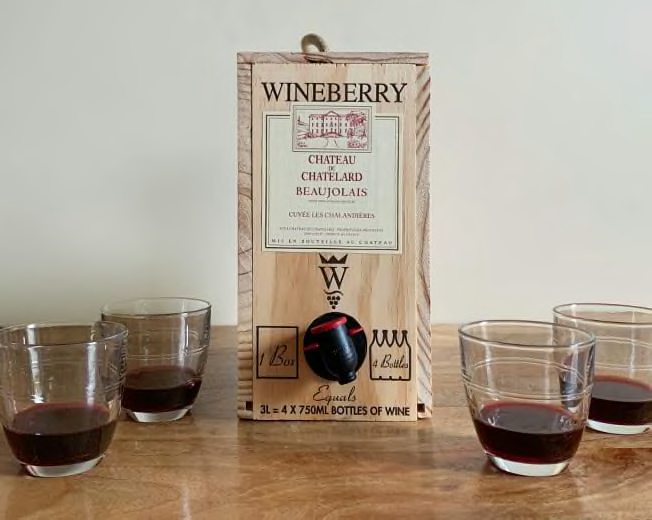
Photo: Angela Lashbrook/Consumer Reports
Price: From $39.99 for 3 liters
Size: 3-liter bag-in-box
Where to buy: Astor Wines & Spirits or Drizly, or check availability
This attractive, hefty wooden box would look inviting and elegant on a sideboard at a dinner party, but more importantly, it contains a juicy, graceful Beaujolais ideal for a wide variety of situations. Notes of blackberry and currant are grounded by a dry earthiness that keeps the juice from verging into too-sweet territory. Many of our evaluators said they’d serve this at a social gathering because it’s balanced and easy to drink. One taster, who typically prefers dry, minerally whites, loved this delicate Beaujolais that tastes much more expensive than it is, though another evaluator said it was a bit too bright for his tastes. Those who prefer a softer gamay may want to look elsewhere. We’d eat just about anything with this lovely, balanced wine, but finer party foods—high-quality cheeses, salumi, roast chicken—would make for delightful pairings.
The Shape Shifter: Château Montaud Côtes de Provence Rosé
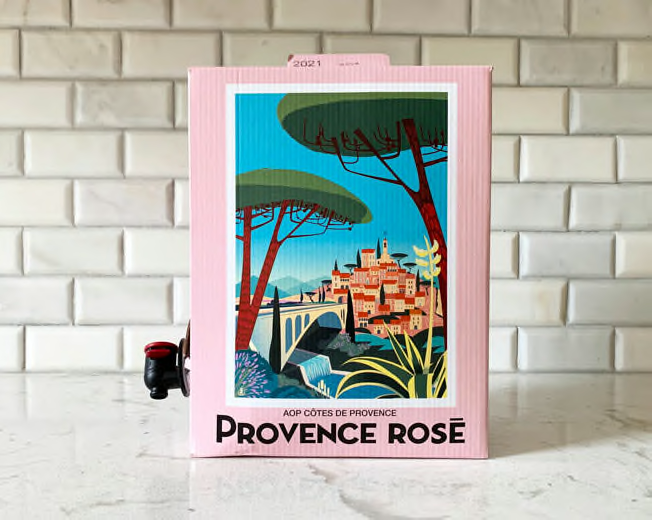
Photos: Angela Lashbrook/Consumer Reports
Price: $30.99 for 3 liters
Where to buy: FreshDirect
This was my husband’s favorite—he said he “wouldn’t know it’s from a box.” It’s a juicy, medium-bodied wine, with a silky mouthfeel and subtle tannins. With notes of summer dew melon, strawberries, and honeysuckle, this wine is rich and complex but still easy to drink and for almost any regular rosé drinker. I can fully imagine gulping down glass after glass at a dinner party (and I, in fact, did bring this box to a friend’s house, where we drank multiple glasses alongside a delicious meal of fish tacos). This isn’t a revelatory wine, but it’s not dumb, either, making it ideal for folks who want to contemplate their wine as well as those who just want a drink without giving it too much thought. On the hottest summer evenings, when a day’s worth of sun has melted your brain into a murky, steaming puddle and you’re no longer capable of complex mental processes, this is the rosé you should reach for.
The People Pleaser: Black Box Pinot Noir 2019
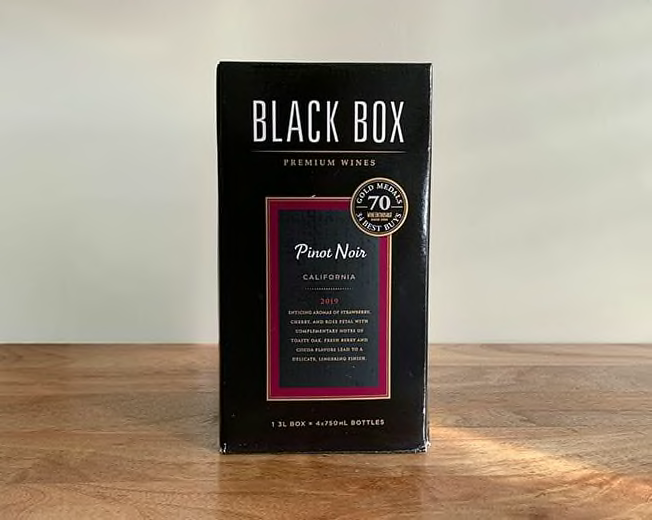
Photo: Angela Lashbrook/Consumer Reports
Price: From $19.09 for 3 liters
Where to buy: Drizly, FreshDirect, or Total Wine, or check availability
The top spot was a toss-up between the Chateau du Chatelard and the Black Box Pinot Noir, so let the record show that we adored this pinot almost as much as the Wineberry (though the elegant packaging of the Wineberry gives it the edge). Strawberry jam and baking spices mingle in this light-bodied, easy-to-drink red with low tannins, which provide that slightly bitter, astringent quality with a “grippy” mouthfeel that many red wines have. It’s a straightforward wine that would make an excellent choice for drinking alongside your favorite crackers and a sharper cheese, such as manchego. One reviewer said it has notes of cherry, cocoa, and clove, and that it “tastes fancy.” Another, however, mentioned that it had some sweetness that he disliked.
Put It on Ice: Les Alliés Grenache Rosé
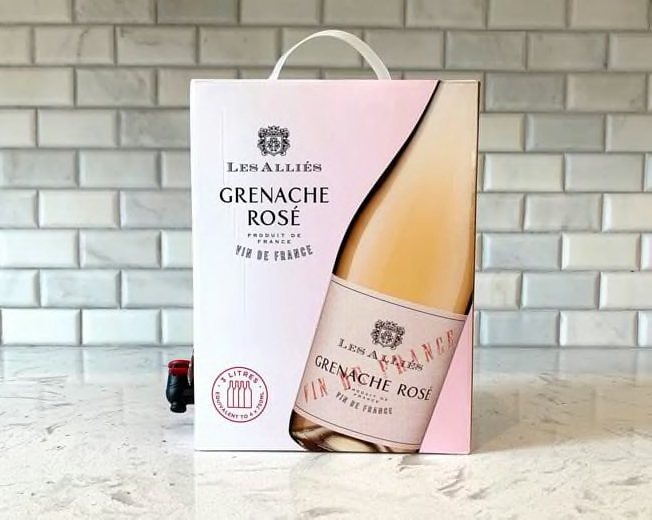
Photos: Angela Lashbrook/Consumer Reports
Price: $23.99 for 3 liters
Where to buy: FreshDirect
This is a creamy, full-bodied, assertively fruity wine, with raspberry, hibiscus, and plum. It’s absolutely a rosé pick for folks who enjoy a bold, slightly sweet glass; those who want their wines to be bone-dry may not like this one. You’ll want to make sure this wine gets plenty of time in the fridge, because it is not at all drinkable at warmer temperatures; on the flip side, should you ice this wine, we won’t judge. In fact, we think it calls for it. Who cares? Serve this to your most easy-going friends, and keep it far away from the snobs.
Best White Wine: Black Box Sauvignon Blanc
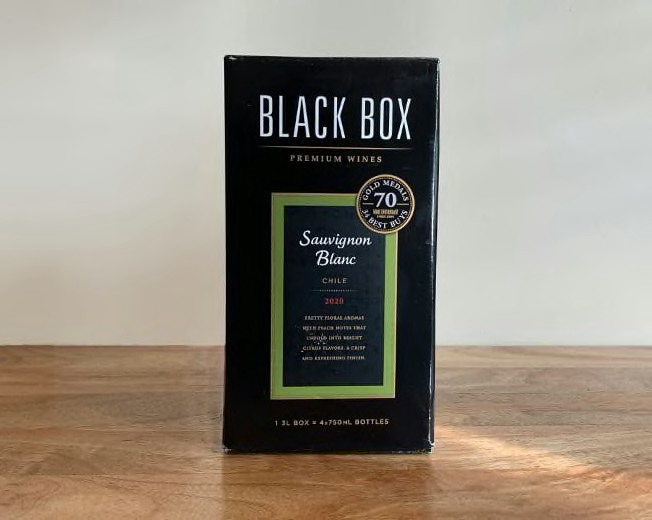
Photo: Angela Lashbrook/Consumer Reports
Price: From $19.09 for 3 liters
Where to buy: Drizly or Total Wine, or check availability
This Sauvignon Blanc is a great party wine, the kind of drinkable white that will appeal to almost any casual wine drinker. Grapefruit, tropical fruits, and green apple dominate in this smooth, light-bodied Chilean. We’d drink this with soft triple-cream Brie or even a shrimp cocktail. One evaluator said he’d buy this wine for fun, casual gatherings such as a birthday party or a high school reunion, though others said that, while drinkable, it lacks complexity.
Best Box From Trader Joe's: Domaine Bousquet Natural Origins Organic Malbec
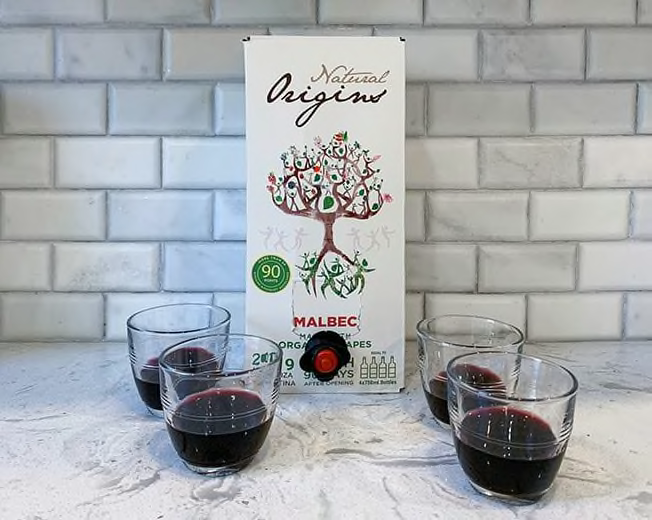
Photo: Angela Lashbrook/Consumer Reports
Price: From $17.99 for 3 liters
Where to buy: Drizly, ShopWineDirect, or Trader Joe’s
Malbecs are typically rich and heavier in body than many reds, making them popular with true red wine lovers. Our evaluators loved this wine, and though the white wine fans wouldn’t pick it up again, they admitted it’s nevertheless a delicious representation of the varietal. Cranberry, vanilla, and tobacco unite in this natural, organic wine that would taste beautiful in front of a fireplace in the dead of winter. Drink this alongside some hearty, warming beef stew—or if you’re enjoying your glass of malbec in the summer, a hamburger.
A Bolder Choice We Loved: Bota Box Cabernet Sauvignon
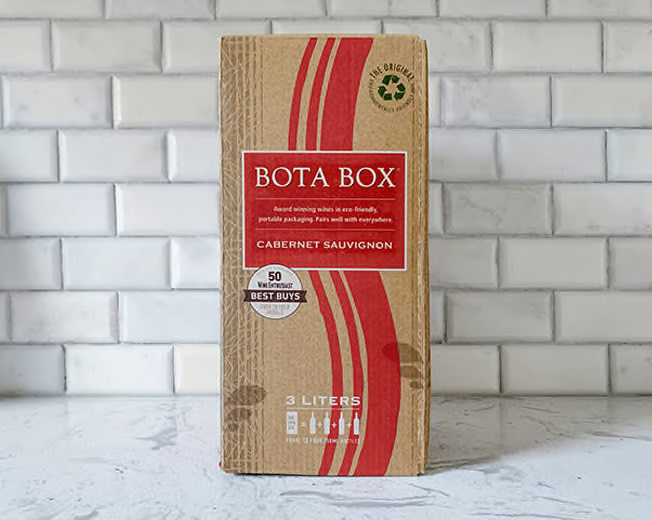
Photo: Angela Lashbrook/Consumer Reports
Price: From $18.99 for 3 liters
Where to buy: Drizly or Total Wine, or check availability
Another big guy, this cabernet is redolent of blackberry; cherry; firm, assertive tannins; and an undercurrent of oakiness. We’d take this camping: It has a similar warming appeal as the organic malbec but feels a bit more down-to-earth. One of our tasters said it has a lovely lingering finish. This might not be the most highbrow cab you’ve ever had, but it’s perfectly serviceable. Our ideal food pairing with this unassuming wine? An all-beef hot dog, with or without the works.
Best Sweet Wine: Bota Box Moscato

Photo: Angela Lashbrook/Consumer Reports
Price: From $19.99 for 3 liters
Where to buy: Drizly
While this moscato is truly very sweet, its crisp acidity and apricot flavors make it palatable instead of one-note. We’d drink this in small portions, over crushed ice, as a lovely way to round out a meal.
Other Wines We Tried
Naturally, not every wine was a winner. While the Jenny & Francois “From The Tank” Chardonnay (from $33 for 3 liters, available for purchase at Astor Wines & Spirits and Drizly) was promising—it is a favorite among Astor’s wine sellers—most of our evaluators found it sharp and almost metallic. One taster liked its “bright salinity” and “distinct minerality,” however, so if you’re drawn to particularly stony, dry whites, you might want to consider this one.
Trader Joe’s Block ’67 Cabernet Sauvignon (from $12.99 for 3 liters, available at Trader Joe’s or through Drizly) was likable but didn’t knock anyone’s socks off. One evaluator appreciated its clove and nutmeg notes, but another said it tasted “rustic, almost homemade.”
Bandit Pinot Grigio (from $8.95 for 1 liter, available at Drizly and FreshDirect) is an inoffensive—but not especially memorable—representative of its varietal. Lemongrass, a hint of sweetness, and a zesty finish mean it’s unlikely that anyone who generally likes pinots grigios would hate this, but would they go back for more? It’s sold in an unattractive Tetra Pak, a shelf-stable carton that may be made with recycled materials but is difficult to recycle after it’s produced. Like a bottle of wine, it’s good for only a few days after opening.
Moscato’s downfall is when its sweetness overwhelms its flavors and aromas, and unfortunately, this was the case for the moscatos from Franzia (from $14 for 5 liters, available at Drizly and Walmart) and Barefoot on Tap (from $19.99 for 3 liters, available at Drizly). The Barefoot has a “weirdly sour smell,” according to multiple tasters, while the Franzia tastes like “apple juice and dive bar,” which may appeal to some tasters.
How We Evaluated These Wines
We aren’t going to lie: This was a fun story to work on. We chose some of the most popular and widely available boxed wines we could find and consulted with wine sellers at Astor Wines & Spirits and Trader Joe’s in New York City for recommendations for delicious boxed wines that are widely available.
None of our dozen panelists is a sommelier, but neither are the people most of us serve wine to in our homes. We interviewed a wine seller and a wine chemist about the advantages and disadvantages of boxed wines vs. other packaging styles. Then we each hosted wine tastings in our homes with friends and family, with whom we sniffed, swirled, tasted, discussed, and documented tasting notes and general observations about each of the 11 wines we purchased.
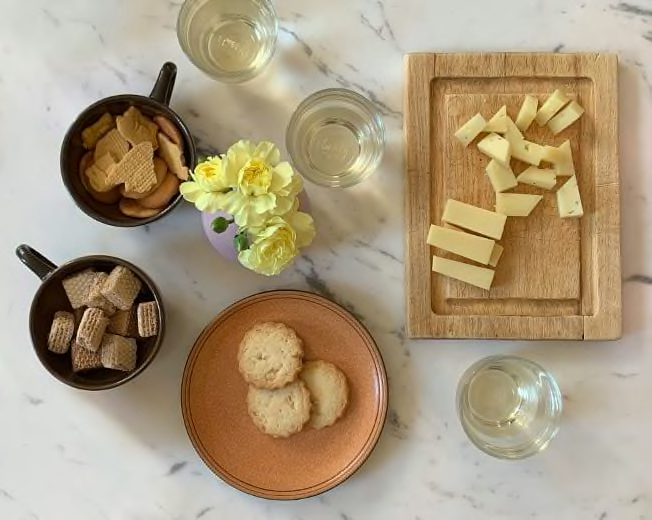
Photo: Angela Lashbrook/Consumer Reports
We judged this wine by several criteria. First, we noted its aroma. How rich and fragrant was the wine before tasting? What odors did we detect? Then we took a sip and assessed how it tasted, writing down the flavors we noticed, as well as its balance, its complexity, its brightness, and its depth. Then we considered its finish—whether the wine vanished from our palates as soon as we swallowed or whether it lingered like a welcome guest (or like an unwelcome one). We also compared it with the characteristic flavors commonly used to describe the varietal, in case it diverged from the typical pinot, cab, and so on. Finally, we asked ourselves if we would buy it, and for what occasion.
A Million and One Advantages of Boxed Wines
It lasts a long time once opened. Industry professionals have a more accurate term for boxed wine: “bag-in-box.” Most boxed wines actually come in a plastic pouch with a polyester outer layer. The bag is filled under vacuum, so there’s no air in it. This bag shrinks as you pour the wine from the spout, which keeps the wine fresher much longer than wine in a bottle, which of course stays the same size no matter how much wine you’ve drunk from it.
“Most 3-liter boxes will stay good for up to six weeks after they’ve been opened,” says Chris Leon, owner of the Brooklyn, N.Y., wine shop Leon & Son. A box is the ideal option for someone who wants merely a splash of wine here and there, he says. “I even know some wine professionals who will keep a box in the fridge for when they just want a quick glass.”
This applies only to bag-in-box wines, from which you pour via a spout, though. Bandit, which makes the pinot grigio that we tried, sells its wine in Tetra Paks, a multilayered, shelf-stable packaging that brings to mind plant milks (many of which are packaged in Tetra Paks). Like with a bottle of wine, air replaces wine as the juice is poured—so while Tetra Pak wines are shelf-stable prior to opening, they need to be consumed within a few days of cracking the seal.
It’s inexpensive. A box is economical, which makes it a great choice for parties: You can get some pretty good stuff without spending an arm and a leg if you’re having a ton of people over. Unfortunately, many wine drinkers have been taught to equate price to quality. “I think the thing that gets in the way of people’s perception of boxed wine is that it can be really inexpensive,” Leon says. Per ounce, it can cost half as much as what you’d get in a glass bottle, and it can still be quality wine, he says.
This is partly because glass is more expensive, he says. It’s also more difficult to ship: Glass is much heavier than plastic and cardboard, and takes up more space than a box, which can be stacked without any space in between parcels.
It’s more environmentally friendly. Boxed wine’s lighter weight and stackability makes it much more sustainable to transport because you can fit more on a single truck or ship, and it’s less of a burden on the vehicle. But even aside from the transportation element, boxed wine has a lighter environmental footprint than wine in glasses.
A 2018 life-cycle analysis by the University of California, Los Angeles, looked at the most popular forms of wine packaging and assessed them according to three criteria: how much energy it consumes, how much its life span contributes to global warming, and how much it contributes to acidification of air, water, and soil. It found that kegs were the most sustainable (though not many of us go through that much wine in our own homes), and boxed wines—despite the plastic bag inside—were a close second. Note that this doesn’t mean boxed wine is positive for the environment; it’s just not as bad as glass. Tetra Paks are light and easy to ship, but they’re extremely difficult to recycle, according to a 2021 review of the available literature on how wine packaging affects the flavor of wine.
And a Few Disadvantages
Boxed wine has a sell-by date. While bag-in-box wine has an impressive shelf life after it has been opened, its longevity is limited before opening. “The big issue with bag-in-box wine is that as a container, it doesn’t keep oxygen out as well as glass bottles,” says Andrew Waterhouse, PhD, a wine chemist and the director of the Robert Mondavi Institute for Wine and Food Science at the University of California, Davis. “The plastic is designed to absorb oxygen, but that only lasts for a few months. Basically, after six months, the wine will start oxidizing pretty quickly.” You’ll know it’s oxidized if the wine has a distinctly nutty flavor, rather like sherry, he says.
Don’t plan to age your boxed wine, Waterhouse advises, and check the sell-by date when you purchase.
Forget about boxed Champagne. Most champagnes and other traditional sparkling wines, like cava and prosecco, require strong packaging that can handle the pressure of carbonization. “You can’t do sparkling wine in a box,” Waterhouse says. “No way could those bags hold the pressure.” Very lightly fizzy wines, like some moscatos, may work in a bag, he says. Otherwise, this is a category that’s best in a bottle or a can.
And consider sticking with fresh, young wines. If you’re shopping for boxed wines, you may want to stick with lighter, younger styles, such as a vivid gamay or a juicy pinot noir. Boxing is great for snappy, fresh, bright wine, whether that’s rosé, white, or even red, especially wines aged in stainless steel rather than oak, he says.
This doesn’t mean you can’t get boxed wine in a richer style. Case in point, the malbec we evaluated and enjoyed. It’s just less common, so you’ll have to look harder for the good stuff.
How to Shop for Boxed Wine
Even if you’re unable to find one of our recommended picks in your area, you can still find a perfectly delicious boxed wine in your local wine shop: Smaller winemakers that sell only within a particular region can offer spectacular wines that aren’t available nationally.
Find the right shop. “Find a retailer that focuses on wine,” Leon says. “It helps with the quality of what’s being offered.” Small shops that focus on beverages, specifically—rather than, say, a grocery store or a big-box store—are going to pay more careful attention to what they stock, he says, so you’re more likely to be able to trust whatever you pull from the shelf.
Pay attention to what the box says, too. Leon says that the more specific the information, the better the wine you’re probably getting. If the label states where the wine is coming from, and exactly what grapes are in the wine, “you are already way ahead of the game,” he says. For example, on the Wineberry Beaujolais, you can find the appellation, or the official region where the grapes are grown; the winery that made the wine; and where the wine was packaged. These are all indicators that a wine is at least decent, if not better, quality.
Temperature matters. “If you go into a shop and it’s warm in there, then you should walk right back out,” says Leon, adding that the same goes for storing wine at home. “I like to tell my customers—find a fridge, any fridge to put your wine in. Don’t just put it on the counter.” The whole point of boxed wine is that it should stay fresh for a month or even longer, but if it’s kept in a warm place, it’ll affect the flavor of the wine. Take your red out of the fridge a bit before drinking if you prefer it closer to room temperature.
This product evaluation is part of Consumer Reports’ “Outside the Labs” reviews program, which is separate from our laboratory testing and ratings. Our “Outside the Labs” reviews are performed at home and in other native settings by individuals, including our journalists, with specialized subject matter experience or familiarity and are designed to offer another important perspective for consumers as they shop. While the products or services mentioned in this article may not currently be in CR’s ratings, they might eventually be tested in our laboratories and rated according to an objective, scientific protocol.
Like all CR evaluations of products and services, our “Outside the Labs” reviews are independent and free from advertising. If you’d like to learn more about the criteria for our lab testing, please go to the Research & Testing page on our website.
Consumer Reports is an independent, nonprofit organization that works side by side with consumers to create a fairer, safer, and healthier world. CR does not endorse products or services, and does not accept advertising. Copyright © 2022, Consumer Reports, Inc.
Did you find this post useful? Save THIS PIN to your board and check it later at any time!
